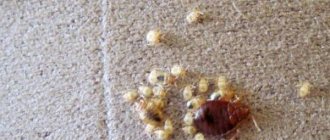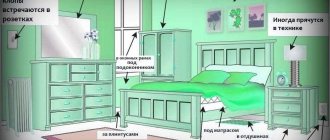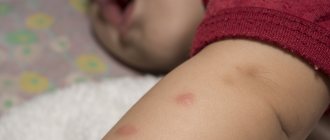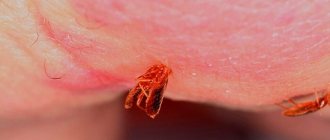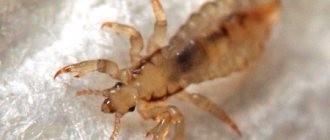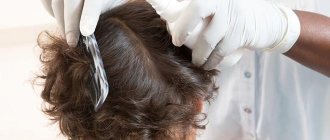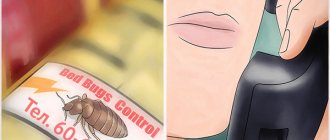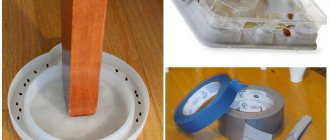- By Vil Malinoshevsky
- About bedbugs
Bedbug eggs are the most important problem, because of which they cannot always be destroyed indoors the first time. Even if the owners of the apartment have taken measures to ensure that parasites do not get in from neighbors, and even if bedbugs are poisoned in a private house, it is because of the eggs that most often it is necessary to carry out repeated treatment.
Bedbug eggs mixed with empty shells and excrement
The point here is that there are no insecticides on the market today that would definitely and completely kill the embryos in bed bug eggs. And almost always, after treatment, it is the bedbug eggs that remain viable.
Consequently, if at the time of treatment there are previously laid eggs in the room (and they almost always are), then after treatment they will hatch into larvae that will have a chance to survive, start biting people, grow and restore the population here.
However, this problem can usually be easily resolved. If you know the specifics of the development of bedbug eggs and larvae, it is relatively easy to destroy them all, including the larvae, which only hatch later. Moreover, in most cases this can be done in one treatment and there is no need to deal specifically with bedbug eggs in any additional way. What do you need to know for this?
Bedbug eggs in an ordinary apartment
Firstly, bedbug eggs are present in all rooms in which these bedbugs more or less regularly bite people. If there is more than one bedbugs, they will multiply and eggs will appear in certain places. Just because you don't see or find them doesn't mean they aren't here.
If the “lid” is closed on the egg, it means that the larva is still developing inside.
Secondly, bedbugs lay the bulk of their eggs where it is damn difficult to get to them. Here, when exterminators inspect a room and prepare it for treatment, they most often find eggs in places where an ordinary person trying to destroy bedbugs on their own would not even look. Typically, masonry is located behind the baseboards, between the boards of the bed frame and sofa, behind the ceiling moldings. If bedbugs were able to get into the filling of a sofa or mattress, then the eggs will be there too.
In other words, the more difficult it is for you to inspect a place, the more likely it is that bedbug eggs will be found there. This is partly why many people don't find them. They look only where it is easy to look - at the mattress from above, at the walls of the sofa, at the same baseboard, only from above, and they see nothing. And you need to look at the seams of mattresses and sofa upholstery.
If you lift such a seam, then it is on the fold under it that you will be able to see eggs, excrement, small nymphs, and sometimes adult bedbugs. You need to unscrew the sofa or bed and inspect all the parts, including fasteners - washers, bolt heads, hinges. You need to unfasten the baseboards from the walls and look at both the baseboard itself and the wall behind it. It is also advisable to lift linoleum or laminate flooring - if there are cracks under them, there may also be eggs there. And so on - in a separate video we talked about where bedbugs can hide in an apartment. Look at it and check all these places - books, shelves, sockets, back walls of furniture, ceiling moldings, household appliances. Most likely you will find eggs.
On a note
Bedbugs cannot lay eggs on humans. They lay eggs only in quiet, hard-to-reach places where they live themselves and into which people rarely look and where the eggs are as safe as possible. There is no such security on the human body or in the body itself. In addition, in their life activities, bedbugs try to minimize contact with people, climbing onto a person’s body for a very short period of time to drink blood, and then crawling into shelters, that is, for them the feeding process is very dangerous and restless. But the main thing is that bedbugs physically cannot lay an egg in the human body; for this they do not have special stylet-shaped oviducts, with the help of which other insects (for example, ichneumon ichneumon fly) perform similar operations. As a result, there are no known cases in which bedbugs would lay eggs not only in the human body, but even on it.
Third: due to the fact that eggs are often located in very hard-to-reach places, they can be extremely difficult to get even with the means by which they can be destroyed. For example, it is impossible to pour boiling water inside the upholstery of a sofa, and somewhere in the gap between the door frame and the wall it is impossible to crush eggs even with a knife.
That is why, in most cases, it is advisable and most effective not to try to get rid of the bedbug eggs themselves, but to take measures to destroy those nymphs that hatch from these eggs. Killing these nymphs is much easier than destroying the eggs, and in most cases, a properly carried out first treatment will ensure that even after this, such hatching larvae will be destroyed.
Methods for destroying the offspring of pests
Considering that the size of the eggs is very small, it will be difficult to find and kill them with your own hands. They are light in transparent shell. In addition, all the places where they are located are sometimes impossible to detect. This means that it is better to destroy eggs in other ways. For example, it is possible to kill growing young animals during the incubation period through direct exposure to low and high temperatures.
Temperatures above 48 and below 22 degrees pose a danger to bedbugs and offspring. Exceeding these limits is encouraged. When thinking, it is recommended to first examine all possible locations of their location: folds of clothing, things, mattresses, blankets, pillows. Cracks, even the smallest ones, should not be overlooked.
Things can be boiled for at least 20-30 minutes. The destruction of eggs in leaks, crevices and cracks occurs with the help of hot steam. You can kill the offspring and thereby interrupt the life cycle of parasites if you use a solution of boiling water, turpentine and kerosene in the proportions, respectively: 150 ml, 15 ml, 20 ml. If the winter temperature drops below 22 degrees, you can take furniture and belongings out into the cold. This will kill the young animals. Chemicals most often do not have the desired effect on bedbug eggs.
What do bed bug eggs look like?
The photo below shows bed bug eggs:
Bedbug eggs on days 6 (left), 8 (center) and 10 (right) of development
Here they are shown at a very close zoom. It can be seen that they are whitish in color, elongated in length. Their length is about a millimeter, their diameter is about a third of a millimeter. The egg in which the embryo develops is translucent, with a visible embryo inside. The shell from which the larva has already hatched is simply dull white.
It is important to understand that the eggs in the photo look completely different from how they look on a real sofa or mattress. The photo is usually taken with a strong zoom and magnification so that the egg on it can be comfortably seen. And in real home conditions, from a distance of 30-40 cm, eggs are lost against the background of debris in a bedbug nest, against the background of fabric or white plaster.
Bedbug nest on sofa frame
Basically, for the sake of simplicity, think of these eggs as being like small, long grains of rice. Each female lays 250-500 eggs in her life, and she does this every day, laying 2-3 eggs per day.
It is therefore obvious that eggs are almost never found alone. After being saturated with blood, the female does not feed for 3-4 days and remains in one shelter, laying 10-12 eggs here. The result is a kind of clutch, although the insect does not make any systematic arrangement of the eggs and does not try to somehow hide or disguise them.
Typical picture when separating the upholstery of an infected sofa from the frame
And yes, do not confuse bedbug eggs with their excrement. The latter look like black dots, and the eggs are white and elongated. In this case, the egg during oviposition is enveloped in a sticky secretion, which hardens over time and the egg becomes glued to the surface. Therefore, simply brushing the masonry off the mattress or sofa will not work. They can only be scraped off with a fingernail or some other tool.
Biology of bedbug eggs in numbers: timing, quantities and optimal temperatures
One egg hatches into one larva. That is, these are eggs, and not egg capsules, like cockroaches. The development period of the egg is from 4 to 19 days, depending on the air temperature.
Under normal home conditions at a temperature of 20-25°C, eggs develop in 7-12 days; this period is longest in wild populations of bedbugs living in caves at a constant temperature of about 14°C.
Bed bugs that feed on bats are wild relatives of indoor parasites
The larva, hatching from the egg, does not feed for 1-2 days and lives off the protein reserves preserved in its body from the period of embryonic development. She then starts looking for a person to feed on. If she succeeds, she sucks on blood and after a few more days sheds her coat, increasing in size.
When does hatching occur?
Room temperature is best for breeding. On average, 5-7 days are enough for a whole colony of bedbugs to appear in the house. If the room is cold (within 8-15 °C), this cycle will take a little longer - 20-25 days.
A female bedbug lays up to 12 eggs per day, and each time she does this in different places to expand its range. An adult insect lives 30-40 days, and during this period it is capable of hatching half a thousand larvae.
Why are eggs so difficult to destroy?
The egg itself protects the embryo very well from various external influences. Through the shell of the egg there is very little gas exchange with the environment and toxic substances do not penetrate inside. Even if the outside of the egg is sprayed with a product and the product dries on it, the larva will not come into contact with the drug when emerging from the egg.
The fact is that it hatches through the upper narrow side of the egg; there is even a special cap that the larva pushes out to get out. So she pushed the lid out, got out and left, without even getting dirty in the product that was on the surface.
Actually, this is exactly what happens after disinfestation. The handler sprays the product over all the places where bedbugs are found, including all the eggs (if he is a good exterminator who has previously opened all these places). Adult bedbugs and nymphs that were in the apartment at the time of treatment die. At the same time, there are eggs in the apartment that survived the persecution.
Consequently, after disinfestation, larvae begin to hatch from those eggs that were laid first, and gradually over a week or two, larvae hatch from all eggs. After 2 weeks, there are no developing eggs left in the room. Either egg shells or larvae remain here. There are no adult bedbugs here that could lay new eggs - we destroyed all of them during processing.
Please note: we are now talking, let’s say, if not about an ideal situation, then about a very good one, in which we are absolutely sure that new bedbugs are not getting into the room from the neighbors. That is, this is either a separate private house, or an apartment with excellent repairs, where bedbugs cannot get in from neighbors and into which they were accidentally brought by people.
If neighbor bugs can get into the room, then even before the larvae hatch from all the eggs, adult insects can get in here and begin laying new eggs. But let’s say we really have a room where bedbugs don’t get into.
What happens to eggs after conventional processing (and does anything happen at all?)
If there were not very many bedbugs before treatment, and the baiting was carried out with a product that has a residual effect, then all the young larvae die from this product. These larvae are very small, crawl slowly, and when they hatch from the eggs, they immediately land on surfaces on which a layer of dried preparation remains. Since they move slowly, they come into contact with this drug for a long time, become heavily soiled in it, it affects them and they die. If the treatment was carried out really well, then all newly hatched larvae are destroyed in this way. That is, people do not even have time to see these newly hatched larvae and repeated disinfestation is no longer required.
Indeed, problems arise when either there were a lot of bedbugs before the first treatment, or during treatment, agents without a residual effect were used (as a rule, various folk remedies), or the treatment itself was carried out poorly. In all these cases, some of the larvae survive.
If there were a lot of bedbugs, they left a huge number of eggs, many larvae hatched from these eggs, and some isolated nymphs avoided contact with the product, or were resistant to it, and did not die. If the product has no residual effect, then all the young bloodsuckers will run through it without harm to themselves, will grow and eventually mature and begin to reproduce.
The same thing will happen after poor-quality treatment: many surfaces will remain untreated and the larvae simply will not come into contact with the product. And therefore, they will not die.
In all these cases, after 5-6 days, the bugs begin to bite people again. They do not bite very aggressively and not very often, since there are few of them and they are all small larvae that bite weakly and little by little. However, these bites are felt, and if they appear, the treatment must be repeated.
The essence and procedure for reprocessing
This treatment is much simpler than the first. Simply because such small larvae are much more sensitive to the drugs used and die faster, plus they all concentrate near the sleeping areas. They are very small and cannot move quickly like adult bedbugs, and therefore after biting they hide in close proximity to a sleeping person - on mattresses, on sofas, on beds, and the like.
For example, nymphs of the first instar simply cannot leave behind the baseboard - they will not have time to reach a sleeping person from here in a whole night. Therefore, all this young generation is in and near the sleeping places, where it is quite easy to poison them all.
The most important thing in such re-processing is to choose the right time. On the one hand, at the time of its implementation, larvae should already hatch from all the eggs, on the other hand, by this time not a single nymph should have time to turn into an adult bug.
The development period of eggs is 12 days, nymphs turn into adults in 28-30 days. At this age - about a month after hatching - they begin to lay eggs themselves. Therefore, the treatment must be carried out exactly within this period - from 12 to 28 days after the first disinfestation.
In practice, it is better to do this as early as possible. Just so that the parasites bite less people. We carry out repeated treatments only if necessary, if bedbugs begin to bite people after the first treatment, and approximately 2 weeks after the first.
According to our internal statistics for the entire DisinCity company, the need for this arises in approximately 17% of cases.
Simply put, for every 6 treatments after which the bedbugs disappear immediately, there is one such treatment, after which the room needs to be treated again. This is fine.
How to recognize a clutch, what the larvae look like
It is difficult to confuse a bug with another “domestic” bloodsucker: a small bug with a flattened body and a specific smell, usually hides in secluded places and comes out to hunt only under cover of night. Not everyone who has encountered this insect knows what bedbug eggs and larvae look like. Meanwhile, you can detect unpleasant cohabitation just by discovering clutches. So:
- the egg resembles a shiny grain no larger than 2 mm in size;
- has a cylindrical elongated shape;
- the color of the capsule is white, sometimes with a yellowish tint;
- at one end of the egg there is a formation that resembles a small cap.
Externally, the eggs of ectoparasites look like small translucent grains of rice.
But the larvae are similar to adults - they have the same body proportions, but they are much smaller and lighter, appearing translucent.
How to poison young nymphs
There are nuances here regarding the means used for processing. We remind you: there are no drugs on the market today that are guaranteed to destroy bedbug eggs. Some drugs seem to show an ovicidal effect, but no evidence can be found, about other products the sellers themselves say so, but, again, they cannot prove anything, but in fact, a drug that would undergo full testing and show an ovicidal effect, No.
Therefore, for treatment, you need to purchase not a product from which the seller promises an ovicidal effect, but a product that remains active after drying, that is, has a residual effect. The majority of such drugs are - almost all organophosphorus compounds, neonicotinoids, pyrethroids poison bedbugs after drying.
Exterminators against bed bugs use organophosphates or neonicotinoids, sometimes more exclusive drugs. For household use, this is Karbofos, for example, Fufanon, Executioner, Get.
Modern drugs called Dichlorvos, as well as such popular drugs as Tsifox or Medilis Cyper, contain cypermethrin or other pyrethroids and it is better not to use them against bedbugs.
It is necessary to treat the apartment with preparations based on FOS so that the product remains on the maximum number of surfaces - on the back walls of furniture, on baseboards, on the bed frame, even on the mattress - wherever bedbugs can come into contact with it. You will cover the same mattress with a clean sheet, you will not come into contact with it yourself, but the bedbugs will run on it. And they will be poisoned.
It is important not to wash off the product from surfaces after treatment. The longer it stays here, the more bedbugs will die from it and the more likely you will not have to poison them again.
...and is it possible to kill them without insecticides?
Eggs can definitely be killed by high temperatures. Adult bedbugs die at +45 degrees in 45 minutes, and at +50 in 10 minutes. It is not known how quickly eggs die at these temperatures, but boiling water and steam from a steam generator or a simple iron kills them instantly. That is, if you use a steam generator to treat a mattress with eggs on it, no one will hatch from these eggs.
Another thing is that you can’t get to many places where eggs are located either by steam or by boiling water. For example, behind the same skirting boards, if they are not removed, or under linoleum. And, for example, books on shelves cannot be treated with boiling water at all, although bedbugs often settle there, including in bindings. That is why, despite such effectiveness, it is usually not possible to destroy all bedbug eggs in a room using either boiling water or steam.
If eggs are found on bed linen, this linen can be washed in water at 55-60 degrees. With this type of washing, the eggs will die, and in the washing machine they will be washed off from the fabric.
But mechanically crushing the eggs or simply removing them from the furniture will not work. When laid, they are covered with a sticky secretion, which sticks to the surface. This protects them from simple swiping, for example. It is also difficult to crush them due to their small size - somewhere under a fold of upholstery or a seam of a mattress, it is simply impossible to press them with your finger. But the main thing is different: it is almost impossible to find all the eggs in the apartment, because they can be “scattered” literally in all the small crevices and are not noticeable everywhere.
At what temperature do they die?
In winter, at -20°C, it is enough to leave the affected items in the cold for one day, and at -10°C, a week of freezing will be required. If the thermometer drops below 30 °C, the bedbug larvae will die in a few minutes.
Things are treated with a hot solution of soda or peroxide, if this does not harm the material.
In a warm room, parasites feel great if the temperature does not exceed 35 °C. Upon reaching + 40 °C, 7 days of existence in such an environment is enough for death. If you increase the temperature to + 45 °C, the embryos will not survive even a day.
And the 50 degree mark kills in a few minutes. At + 80 °C, instant death occurs. If at least one couple survives after cleaning, the problem of bedbugs in the house will resume again within 3-4 weeks, so disinfection is carried out carefully, in all secluded places.
